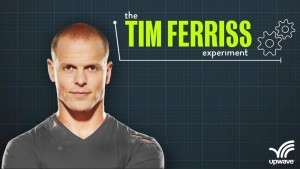Tim Ferriss, author of the 4-Hour Workweek, entrepreneur, startup investor and lifestyle designer, started on the groundfloor and worked his way into a best selling author through his not just his intellect, but through his marketing techniques. Here are ten marketing lessons I’ve learned from Tim Ferriss.
1. Personally connect with people.
Connections are such a key part of any type of business, without them you will not succeed. Having the ability to make a personal connection with your customers is a great tool to have and you will find great success with it. If your customers feel like you have connected with them personally, they’ll feel special and people who feel special want more of that feeling. If they know that coming to you makes them feel important they’re going to keep coming back for more. You can also use this to your advantage as well, if you are personally connected with your customers you can understand what they want and be able to better shape your content towards what they’re looking for.
2. Interview other people who can provide value to your audience.
No one can expect you to do absolutely everything by yourself, and if you’re the only person appealing to your audience, after a while they’ll get tired of it as well. Keep your content fresh and do yourself a favor by having other people join you from time to time. This can include anything such as interviewing other people, especially people who can provide value and something different to your audience. Tim Ferriss keeps his content fresh by interviewing different people on both his television show and his podcast, adding new and interesting content with every new episode to keep his audience entertained.
3. Always have a call to action.
When promoting your business and product, a key way to make sure you are always providing enough information to your audience is to assume that they don’t know much. Make sure you add enough quality information to clearly get your message across. Your audience won’t know what you want them to do unless you specifically tell them, by providing a call to action. Your call to action message should be a clear and direct statement telling your audience what you want them to do with your message in order to reach some goal. Call to actions can even be as subtle as renaming a page on your blog showcasing your podcast from “Podcast” to “Listen to My Podcast!” – as long as it is clear and direct.
4. Showcase how other industries could offer insights.
Bringing in people from other industries to add content to your blog can be a great way to keep your content engaging, but at first it may seem like their specific industry has nothing to do with your own. Tim Ferriss has overcome this by always being able to connect one industry back to his own. This way you can have a variety of people adding content while still being relevant to your audience. For example, Tim Ferriss recently interviewed “The Iceman”, a daredevil who is infamous for being capable of enduring extreme cold temperatures. At first glance, this may not seem like it’s relevant to Ferriss’ audience, but he connected it back by noting that although you may not be attempting any of the Iceman’s adventures on your own, you can learn something from his endurance and internal strength to add to your own life. It’s important to always make the connection between other industries and your own so your audience can take away more from your content then they were originally expecting to.
5. Create a clear focus for what your brand stands for and create strategies to implement this.
Having a strong message that embodies your brand is a huge part of the brand building process and shouldn’t be ignored; it’s also important to keep your message consistent. Focus on what your brand stands for and utilize your marketing strategies to remind your customers what your message is. For example, Tim Ferriss is known as a lifestyle expert and entrepreneur who left a corporate career for one of traveling while running a business. How does he continue to showcase this element of his brand? For his birthday every year he offers different gifts to his fans to get them involved. One year it was a free round-trip ticket to anywhere in the world and another it was 100,000 cash, plus a round-trip ticket. Marketing strategies like this further enforces his brand message and reminds all of his customers what his brand is all about.
6. Offer your product for free in exchange for honest reviews to jumpstart the buzz.
One of the best ways to ensure that people will buy your product is if it has good reviews. Consumers are beginning to trust the reviews left by other consumers even more than word of mouth these days so having good reviews on your product is an absolute must. A good strategy in order to gain reviews is to offer your product for free to a certain group of people in exchange for honest reviews (make sure you’re not asking them for positive reviews, if your product is of good quality they will say so). Most people will jump on this offer and will be more than happy to take a few minutes out of their day to leave a review on your product. This will jumpstart the buzz on your product and gives other consumers reviews to help them make a decision.
7. Create your own lifestyle that works for you instead of accepting the status quo.
The entire story of Tim Ferriss’ success begins with the change that he decided to make in his own life in regards to his career. Having come up with the idea of the Four Hour Work Week as a solution to his workaholic lifestyle, Tim Ferriss completely changed his lifestyle to fit his needs and desires. At the end of the day, the most important thing in life is you. You have to do what’s right for you personally and everything else will fall into place. Take your career in your own hands like Ferriss and create your own kind of lifestyle that works for you. Just because the world dictates that a 9 to 5 job is the status quo doesn’t mean you have to abide by it. Whether it’s giving your career a complete overhaul or even just convincing your boss to let you work from home on Fridays, take charge of your career and your life and make it work to your standards.
8. Experiment with your marketing tactics.
Marketing can be hit and miss, sometimes your strategies will be a home run, and sometimes they’ll strike out. A good rule of thumb is to keep your marketing tactics new, don’t use the same old method over and over again. Don’t be afraid to try a new email campaign, a different blogging approach, or even bring in someone who can evaluate your current marketing efforts and let you know where you might be missing a beat. Sometimes a revitalization of your marketing tactics will be just the key you need to get things going, so don’t be afraid to experiment and see what works.
9. Perfect the soft-sell method.
One of the most key things to remember when promoting your product is it’s completely unnecessary to oversell your product to your audience. Perfecting the art of the soft sell will work wonders for your business. There is no need to annoy your audience to buy your product; instead, keep them interest in what you have already been doing and they’ll continue to come back for more. Tim Ferriss calls this the “soft-sell method” and uses it whenever he is promoting a new book or product he’s selling. For instance, when Ferriss had a new book coming out he announced it three months in advance and then kept his content from there on focused on what the book would offer, rather than continuously reminding his audience to buy his book. In the post where he announces the book even, the content is subtle. He’s not in your face asking you to buy, buy, buy – instead, he’s simply showing you what you’ll get out of the book if you choose to purchase it.
10. Offer exciting incentives that people will desire.
Most businesses have jumped on board the incentive bandwagon; everyone knows that offering incentives is a sure-fire way to bring customers in and keep them there. If a customer were getting something extra in return for their business, why wouldn’t they want to keep coming back? To stay ahead, you have to be offering something more exciting than your competitors, something your audience will absolutely desire and have to have. Tim Ferriss accomplished this by offering over $4,000,000 in prizes in exchange for the purchase of his new book through different packages. As Tim Ferriss has shown, if you want people to buy your product, offer them something exciting and spectacular in return; make the decision of whether or not to buy your product a no-brainer.


 Social media has made the world much more transparent in the last decade. Beginning as a platform where you post pictures of yourself and share experiences with friends and family, social media now engulfs a major part of our everyday life – including how we learn and get inspired.
Social media has made the world much more transparent in the last decade. Beginning as a platform where you post pictures of yourself and share experiences with friends and family, social media now engulfs a major part of our everyday life – including how we learn and get inspired.